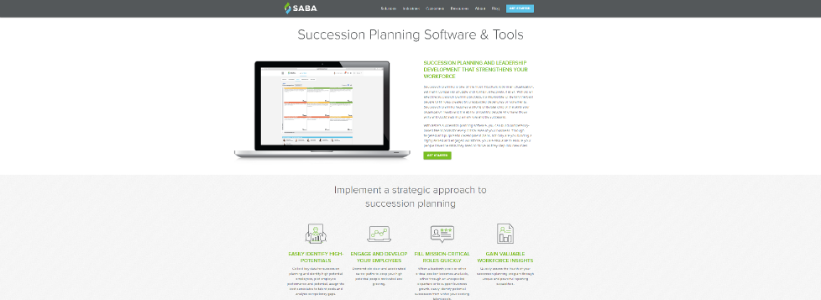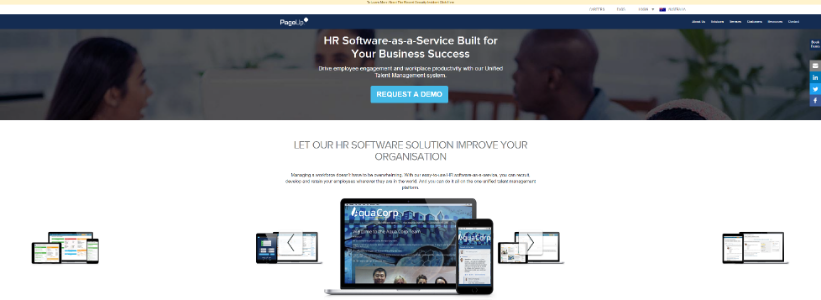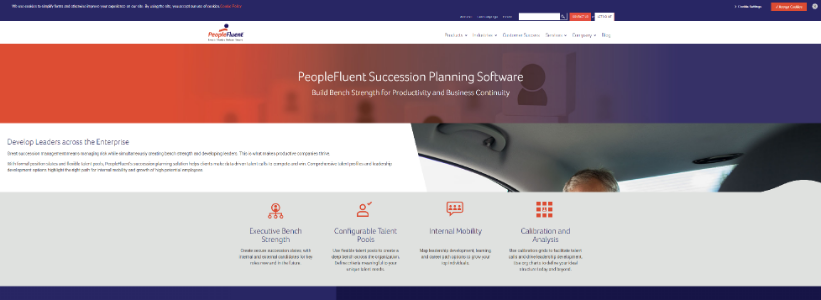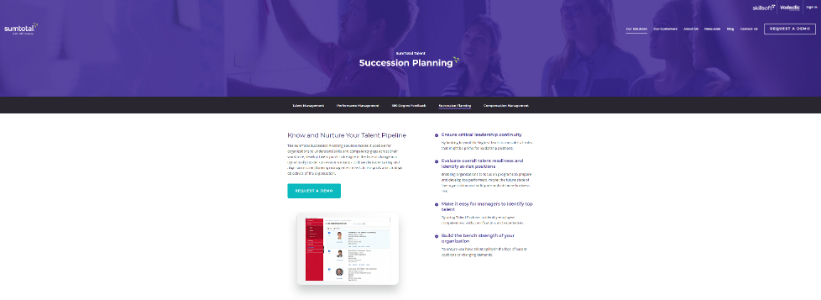Top 11 Succession Planning Tools for Business and Management
Succession planning is a process of determining critical roles within the company, identifying and assessing possible successors, and providing them with the appropriate skills and experience for present and future opportunities.
In other words succession planning comprises of these important steps:
- Recruitment and staffing – you recruit superior and right employees
- Training and development – you train the employees to develop their knowledge, skills and abilities
- Performance and Compensation management – prepare them for advancement or promotion into ever more challenging roles
- Other (in which talent management plays a role) – you are prepared to retain or replace superior employees
Typical activities covered by succession planning include:
- Determine what roles and skills are critical for the growth of the company
- analyze and address the gaps revealed by the planning process
- identify and understand the developmental needs of employees to fill those positions
- ensure that all key employees understand their career paths and the roles they are being developed to fill
- train people for skills and positions that are not presently existing in the company
- understand the time needed to backfill key roles
- enrich succession plans through regular executive discussion of people and posts
- identify top performers in all departments and make sure that they are engaged and satisfied to stay with you for a long period
- continually review and check the process of succession and whether planned individual development has taken place
Succession planning is a process by which successors are identified for key positions throughout an organization including vital roles in each department of the organization. It should take into account the strategic vision and objectives of the organization. With good succession planning in place, employees are ready for new leadership roles so when someone leaves the company, another is skilled and ready to step-up to that position. Succession planning can also help develop a diverse workforce, by enabling senior management to look at the future goals of the organization as a whole. So the key issues the HR professionals should consider while developing a succession plan are:
- Strategic plans and future goals
- Workforce requirement
- Knowledge retention and critical roles
- Talent management strategies
Succession Planning Tools
Succession planning starts when you can accurately measure the performance of the employees assess skills and career growth information. Succession planning tools need to have extensive integration and customization options to support all of your talent management efforts.
To identify a correct succession planning and talent management system you need to have a software that:
- Has a performance management system that delivers accurate data
- Self-service online resumes for employees
- Has a recruiting system that enables to transfer information on new hires directly to your succession planning analysis and data
- Integrates with your HRIS position/job management data with links to competencies and other qualifications
- Is a powerful bench strength assessment tool that can share, review and analyze data to provide latest and updated information
- Uses easy interactive tools or matrices for assessing employee potential, flight risk and impact of loss
- Provides the needed framework for effective gap analysis
- Has a search capability based on multiple filters and employee characteristics
- Provides a view of your succession plan in any format, including organizational charts with concern areas highlighted
- Provides with a complete career inventory data for each employee readily at hand, managers can specify targeted future jobs for colleagues and indicate a readiness timeframe
- Customizable email reminders
- Informative visual reports and dashboard
Top 11 Succession Planning Tools and Software for Business and Management:
TALENTGUARD
TalentGuard succession planning software can help your company identify and develop future high potential leaders within your organization.

TALENTGUARD
SABA
Use Saba collaborative Succession Planning Software to develop and nurture leaders, optimize organizational performance and reduce risk. Ask for a demo today!

SABA
CORNERSTONEONDEMAND
Our leading talent management system provides recruitment, training, management, and collaboration solutions for all business sizes. Schedule a demo today.

CORNERSTONEONDEMAND
PAGEUPPEOPLE
PageUp’s innovative HR Software is configured to make your business more efficient & profitable. Manage your talent with ease, request a demo today!

PAGEUPPEOPLE
PEOPLEFLUENT
PeopleFluent is a leading independent provider of cloud based integrated recruiting, talent management, and compensation management solutions.

PEOPLEFLUENT
ASCENTIS
Ascentis Succession Planning software helps you manage the challenges that come with low levels of employee engagement, the high cost of turnover and the demands of managing a global workforce. Employees are engaged in their career development, while managers have full visibility to see career growth opportunities for their teams.

ASCENTIS
BIRDDOGHR
BirdDogHR Succession Planning software is a cloud-based solution that allows companies to accurately review employee performance and readiness with scorecards, comparative ratings and 9-box Talent Matrices.

BIRDDOGHR
CORNERSTONEONDEMAND
Our leading talent management system provides recruitment, training, management, and collaboration solutions for all business sizes. Schedule a demo today.

CORNERSTONEONDEMAND
SUMTOTALSYSTEMS
The SumTotal Succession Planning solution makes it possible to understand skills and competency gaps, develop talent pools and dynamically model succession scenarios.

SUMTOTALSYSTEMS
EMPXTRACK
EmpXtrack helps companies manage succession planning,an important factor for ensuring continued organizational success, effectively.

EMPXTRACK
ANAPLAN
Anaplan’s connected planning platform enables organizations to accelerate decision making by connecting data, people, and plans across the business.

ANAPLAN
***
Models of Succession Planning
There are three main models that companies use to implement succession planning:
- Short-term planning or emergency replacements
- Long-term planning or managing talent
- Combination of above plans
Organizations should take a close look at their goals and levels of commitment before choosing a model that best suits their needs.
Short-term or emergency replacements
This is the most common model of succession planning and serves as a crucial point for all types of businesses. Short-term replacement planning is focused on an urgent need caused by a sudden development within the organization – skilled employee leaving the company, expansion or contraction of business. Sometimes, emergency replacement planning must work to retain knowledge that is about to be lost. Emergency knowledge retention is an option to consider if the organization is about to lose specialized knowledge and does not have a successor to take the knowledge.
Emergency succession planning can come into play any time the organization expands in a new direction or discovers the talent gaps to fill the required managerial position. Generally, human resources will try to fill the role from within the organization, but often go outside, if no one has been trained for the job in the organization.
Long-term planning or managing talent
Talent management focuses on the future needs of the organization. Working within the strategic framework for the company’s future goals, senior management identifies the positions necessary for growth and the best candidates to fill those roles. Some organizations invite all employees to take part in an assessment process, while others have managers identify leadership candidates.
If companies wish to grow leaders from within their existing talent pool and have the time and resources to develop a useful program, effective talent management will become a key component of its long-term human capital strategy. The advantages of this model include:
- Identifies a specialized talent pool
- Defines and builds future skills required for the success of the organization
- Motivates and retains employees by involvement in their career growth
Some of the disadvantages of this type of model include:
- Expensive and time consuming
- Existing employee-base may not have required skills and experience for key posts and outside hiring can lead to resentment
- Managers may be frustrated by not being allowed to choose a successor
Combination of both the plans
This model allows senior management to plan for the long-term growth of both the organization and employees within the organization and prepare for emergency replacements to ensure that business is not affected by knowledge loss or lack of skilled employees.
HR professionals will find that the advantages of succession planning greatly outweigh the disadvantages, which can be overcome by proper planning and communication within the employees and senior management.
Why Succession Planning?
Are you ready to continue business without interruption after losing a strong and effective leader in your organization? Leadership is and has always been a relatively scarce commodity within companies. First, you need to analyze what has made the business successful. Does that success rely on skills or knowledge of the leader that could leave? Next, you need to look at the future of the company. Where are you going and what skills do you need to get there and once you are there? Is that talent currently in your leadership team?
Other important questions to consider are – existing and future market competition, required technology know-how, talent pool of existing employees, and management hierarchy and reporting structure.
Answers to these questions can provide the basis for decisions on whether the business can continue without the leader, how it would continue without the leader, who would lead and how ready they are.
The recruitment of top talent is too expensive due to the rising executive search costs and increased hiring contract requirements, not to mention the lack of knowledge about company culture and inner workings. Recent research has shown that company find more effective leaders by developing from their internal talent.
A careful and considered plan of succession ensures the least possible disruption to the successor’s responsibilities and therefore the organization’s business and efficiency.
Succession planning plays a vital role and is necessary when a key executive or employee is:
- Unwilling to continue the role within the organization
- Accepting an offer from another organization which will terminate or lessen their value to the current organization
- Indicating the completion of a short-term project or task assigned or
- Moving to different position and different set of responsibilities within the organization
A succession plan clearly sets out the factors to be taken into account and the process to be followed in relation to retaining or replacing the person. Succession management systems provide an enabling solution for the planning and process – going through all possible scenarios and providing the best solutions and shortest paths to succession.
Having a decision making body and succession planning process is critical. However, software can help make this process consistent, automated and fair. Succession planning teams can play “what if” scenarios to ensure that they are thinking of all possibilities. They can search for talent throughout the organization – in different organizations and countries. They can also ensure a continual and full pipeline of talent.
Advantages of Succession Planning
We are currently witnessing the impact of an emerging and dire necessity of the new trend of succession planning and talent management systems. HR professionals no longer think just about the replacement of talent, but also focus on development of skills sets and knowledge of employees within the organization and how they can cope-up to the wider roles and responsibilities which are in-line with the company’s goals.
Succession planning helps you take a more strategic approach to leadership development, employee skill assessment and perhaps even more important as baby boomers retire – preserving critical organizational knowledge. With incumbents ready to go any time an expected or unexpected change occurs in your organization, you can ensure business continuity at all levels of the organization.
Organizations use succession planning to achieve a number of objectives like:
- Improve recruitment process for key positions
- Active development of longer-term prospective successors by ensuring their career growth and analyzing work, responsibilities, skills and knowledge required for the future
- Audit the ‘talent pool’ of the organization and that helps in allocation of responsibilities and development strategies and fill the identified talent gaps
- Build a ‘key talent resource’ of employees who share key skills, knowledge, experiences and values seen as important to the future of the organization
To summarize, the main advantage of succession planning in an organization is the active development of a strong ‘talent resource’ for the future which is vital to attract and retain the best and key people which will help in present and more for the future growth of the organization. Have the right people with right skills in the right jobs doing the right things. If they people are doing wrong things then you are right back where you started.
The key is to match the needs of the organization to the goals of the individual. Keeping talented people in place by providing them with opportunities they may not receive elsewhere will create a stronger and more loyal group of future managers and executives thus saving the company’s recruiting and hiring costs over the long-term.
Succession Planning Glossary
360-degree : The process of gathering evaluations of an individual’s performance from varying perspectives (peers, supervisors, direct reports, customers) to create a composite assessment for the purpose of performance improvement. It is sometimes known as multi-rater feedback.
Absenteeism: Scheduled and unscheduled time off from the workplace because of illness, injury, disability, family responsibilities, grief, depression, etc. Surveys show that the rate of absenteeism is a good leading indicator of morale and one most linked to profit margins. Many companies do not know their absentee rate and research shows that its cost is often underestimated.
Accountability: Personal responsibility for the consequences of one’s actions to others. Key tasks that keep an organization running should designate a team or individuals to be accountable for successfully discharging well-defined responsibilities. A good performance management system defines roles and expectations and tracks progress of accountable parties towards goals.
Action Plan: A program of actions (activities, training, new practices, etc.) established to improve current performance, develop key competencies for future performance, or achieve a specific performance goal or outcome.
Adaptive: The capability to modify any individual student’s learning experience as a function of information obtained through their performance on situated tasks or assessments.
Aggregation: A structured collection of learning objects, defined as a parent and its children in a tree structure. Aggregations are used to group related content so that it can be delivered to the learner in a prescribed manner.
Alignment: The process of assuring that high-level business goals (e.g., organizational objectives) are understood at all levels of the organization and reflected in individual goals and action plans. Alignment can also refer to designing any process or stage of a process to support and work cooperatively with other processes or stages.
Application Programming Interface (API): A standardized method for a learning object to communicate with a learning management system (LMS) when a learner is interacting with learning materials.
Application Profile: A collection of standards, specifications and best practice guidelines for using the standards within a particular community of practice. SCORM is an application profile.
ASP: Acronym for “Application Service Provider,” referring to access to a software application via an Internet connection. The application and data are typically remotely hosted by a software vendor. This term is increasingly being replaced by the phrases on demand or SaaS (software as a service).
Balanced scorecard: A management methodology, developed in the early 1990’s by Dr. Robert Kaplan ( Harvard Business School) and Dr. David Norton, which enables organizations to clarify their vision and strategy and translate them into a measurable operational plan. The “balanced” label comes from the scorecard’s expansion of business focus and measurement beyond traditional financial analysis to include “leading indicators,” which are measurements of progress on initiatives viewed from three additional perspectives: customer, internal business processes, and learning and growth.
Baseline data: Initial measurement of a process or performance by an individual, division, department, organization, etc., to establish a basis for future comparison.
Benchmark: A standard or point of reference used in measuring and/or judging quality, value, or change. Benchmarks can be used to compare across individuals or organizations, or to compare the same individual or organization at different times. Benchmarks can be derived from baseline measurement or by measuring or surveying performance at “best-practice” or successful organizations.
Bias (rater bias, measurement bias): A measurement error which obscures the true value of the factor being measured. In performance evaluations, bias is typically defined as a rater characteristic. Common performance evaluation biases include:
- leniency bias (a manager who evaluates employees higher than their performance warrants);
- the “halo effect” and the “horn effect” (one strong ratee characteristic colors all ratings, including those that should be unrelated);
- central tendency (raters tend to rate everyone in the middle of the scale).
Good data analysis can sometimes identify and correct for bias.
Business Performance Management (BPM): Also known as Corporate Performance Management (CPM) or Enterprise Performance Management (EPM), BPM is a set of processes and business measures that helps organizations track, measure, report, plan, forecast and optimize business performance. BPM helps businesses discover efficient uses of their financial, human, and material resources. Processes also include consolidation, management reporting, operational analytics, and scorecard.
Calibration: A higher-level review of performance evaluations and subsequent adjustments to compensate for rater biases that may distort managers’ evaluations of their direct reports, and to make sure that performance ratings represent application of uniform standards and more accurately compare across different managers.
Cascading goals: The process of passing high-level organizational or business unit goals to subordinate business units and/or individual employees, for incorporation into planning activities and setting goals. “Cascading” is often used to denote the pass-down of identically-worded (or very similarly worded) goals, as distinct from the alignment of goals, which allows individual goals to support or link to higher-level objectives while being more personally relevant or specific.
Certification: The process of formally testing and verifying the conformance of materials in accordance with or adherence to a standard or guideline.
Coaching: A service to provide feedback, training and/or skill development, intended to improve the effectiveness of individual contributors or teams within an organization. Coaching can be delivered by professionals from outside the organization or internally by a peer, supervisor or mentor.
Competency: We prefer to think of competencies as the currency of human capital – like financial currency, competencies represent a person’s existing potential to produce tangible results. In performance evaluations, “competency” usually refers to directly observable behaviors, skills, abilities, talents, attitudes, and other personal characteristics that are essential to job performance.
Performance management practitioners often distinguish two types of competencies: “core competencies” in reference to skills and abilities that are essential in every position in a company, and “job-specific competencies,” which vary from one position to another. Also relevant is the concept of competency proficiency, referring to a range of expertise appropriate to different positions for which a competency may be relevant.
Compliance: The degree to which members of an organization practice prescribed policies or regulations. The most common current association is compliance with the provisions of the Sarbanes Oxley Act, but compliance can also refer to the extent to which employees participate in a performance management activity or other required business practice.
Configurability vs. Customization: Configurability for a software application refers to its flexibility for choosing setup options for different parameters of the software. It is distinguished from “customizability” primarily by ease of change; customization typically requires an expert to either modify code or write a special applet or script. In a nutshell, customization may produce a better match to a software client’s preferences and requirements, since configuration cannot anticipate every possible request.
Conformance: Materials that are formally verified to be in accordance with a standard or guideline.
Content Package: A standardized way to exchange collections of digital resources between different learning management systems (LMSs), authoring tools, and content repositories.
Content Repository : A software package designed to manage content in the form of text files, images, etc. throughout its lifecycle, including authoring, versioning control, and distribution of the content. A content repository typically includes the ability to attach metadata to its assets or content and to search for assets or content based on their metadata. The Content Repository functions manage the content and permit locating stored content, authoring new content, attaching metadata to content, managing versions of content, etc.
Content Structure Diagram: A tree diagram created by the instructional designer for the programmer to show the hierarchy onto which the sequencing rules for the learning objects are applied. This diagram should be followed by a list of the behaviors the instructional designer intends for the learner.
Core Competencies: Capabilities that an organization values as critical to its success, and appropriate for all positions within the company.
Core process: The fundamental activities or group of activities, that constitute the essence of an organization – processes so critical that failure to perform them will cause the business to fail.
Dashboard: A graphical, quick-read presentation of metrics designed to represent statuses of important strategic processes and goals at an organizational, business unit or individual level. Some experts distinguish a dashboard from a scorecard by defining the latter as having more of a strategic context, but others suggest any difference is just semantic. Dashboards may be configured in employee performance management software to present different sets of information to different participants, depending on their roles and responsibilities.
Drag-and-drop: Drag and drop is an intuitive Graphical User Interface utility used for easy movement of icons and data on a computer monitor. A common example is the ability in a Windows Explorer-like browser to click on and drag a file icon from one directory to another.
Employee Engagement: The discretionary effort above and beyond meeting minimal performance expectations exhibited by an employee in his or her daily work. Research points to employee engagement as a key driver of an organization’s success in satisfying its customers and, as a result, achieving its financial goals.
Employee Performance Management: An ongoing, broad-based organizational process designed to monitor, measure, empower and improve employee performance and thus to make a profound contribution to the achievements and success of the parent organization. The activities of performance management may include performance appraisal, development planning, aligned goal-setting, 360 degree feedback, talent planning, career planning, salary planning, succession planning, and coaching and training.
EPM: In our usage, this is an acronym for “Employee Performance Management.” In other contexts, EPM can stand for “Enterprise Performance Management.” See Employee Performance Management for further clarification of these terms.
Forced Ranking: A controversial performance management practice used by many companies and made popular by GE during the tenure of CEO Jack Welch. Forced ranking forces managers to rank employees in perceived order of performance quality, often with a target percentage quota for different performance levels. Proponents tout its leniency-fighting accuracy and value in rooting out poor performers. Critics call the practice “rank and yank,” complaining that its heavy handedness can falsely impugn capable employees, undermine teamwork, and cultivate employee resistance.
Gap Analysis: The practice of identifying the difference between a desired result and actual results. In performance analysis, gap analysis is most typically applied in employee learning and development, to identify competency deficiencies and to guide training programs.
Goal/Performance Goal: A performance objective for an organization, department, team or individual. A commonly used rule of thumb for goals is that they should be SMART – specific, measurable, attainable, realistic and timely (with some variations on what the five letters stand for). However, high level goals (“improve customer satisfaction levels”) are often less specific than individual employee goals (“improve response time to customer inquiries by 25%”). One of the big challenges in performance management is linking individual goals to corporate objectives.
GUI: Acronym for Graphic User Interface, meaning the interface of human and machine. Typically, the presentation of software with graphical elements displayed on screen, associated with keyboard/mouse operations and commands used to access software capability.
Pay for Performance: A process of linking a significant portion of an employee’s compensation to an evaluation of their performance during the compensation period (typically annual). This is distinct from other compensation strategies that base pay on non-performance factors such as seniority, or that fail to distinguish one employee’s compensation from another’s (e.g., awarding all employees a uniform cost-of-living raise). Sometimes also called a “variable pay” system.
Performance Appraisal: The regular (usually annual) process in which a manager and/or other evaluators rate an employee’s performance or capabilities. Performance appraisals may include both subjective competency evaluations and/or performance goal achievements, and often include both numerical ratings and commentary. Appraisals ideally will help an employee understand his or her strengths and how to capitalize on them, and will identify potential weaknesses while providing guidance in addressing them. Appraisals may be done to evaluate employee performance, determine compensation, assess promotion readiness, or simply to help guide an employee’s development. When ratings are provided by more than just a supervisor, including peers, subordinates, and external and/or internal customers, the process is often called 360-degree feedback.
Performance Goal: A target level of the outcome of an activity, or for a product or service, expressed as a tangible measurable objective against which actual achievement can be compared.
Performance Management (Employee Performance Management): An ongoing, broad-based organizational process designed to monitor, measure, empower and improve employee performance and thus to make a profound contribution to the achievements and success of the parent organization. The activities of performance management may include performance appraisal, development planning, aligned goal-setting, 360 degree feedback, talent planning, career planning, salary planning, succession planning, and coaching and training. Employee performance management, often abbreviated as EPM, is also called “workforce performance management.” Note that “performance management” without “employee” at the front means different things in different business contexts.
Presenteeism: The phenomenon of people showing up at work when they are sick or otherwise impaired, when they are therefore more likely to work far less efficiently and to spread illness through contagion.
Productivity: The level at which an organization or individual delivers its service or product as a function of resource allocation and consumption (e.g., time, labor, infrastructure). Often difficult to measure at the individual level for knowledge workers; at the aggregate level, productivity is often grossly calculated as revenue divided by number of employees. For this reason, productivity calculations often rise when employees are laid off, though the benefit may be short-term.
Return on Investment (ROI): The ratio of financial gain to financial investment, represented by the equation:
ROI = (Financial Gain – Financial Investment) / Financial Investment
Determining ROI is much easier for stocks and bonds than for human capital investments, where both costs and (especially) benefits are less readily and completely quantified.
SaaS: Short for “Software as a service,” typically referring to an application accessed by users via the Internet and hosted by the software vendor.
Sarbanes-Oxley: This complex piece of legislation was passed in the wake of accounting scandals (most notoriously Enron) in the US economy during the early 2000’s. Compliance with “SOX” requires assertions of accuracy and deeper disclosures by publicly-traded corporations and key C-level officers regarding financial statements. Similar legislation has been passed in the European Union and other parts of the globe.
Scorecard: A measurement-driven methodology designed to operationalize and manage a company’s strategy. The most familiar scorecard is called the Balanced Scorecard, so named because the metrics tracked expand beyond the usual backward-looking financial outcomes that have traditionally defined business success. Besides financial indicators, scorecards will measure results pertaining to the success of strategic initiatives in improving customer satisfaction, improving internal business processes, and elevating the skills and readiness of employees to execute strategy. Such measures are known as “leading indicators.”
SCORM: This is an overview of the Sharable Courseware Object Reference Model (SCORM). SCORM is a suite of technical standards that enable web-based learning systems to find, import, share, reuse, and export learning content in a standardized way.
Sequencing : Sequencing is similar to the CBT term branching in that it describes and prescribes the manner in which the learner receives the content. In CBT, much of the branching or sequencing occurred within a lesson or course as the learner completed different tasks. However, in SCORM, the learning management system (LMS) sequences all activities between the learning objects and the learner, essentially performing all of the sequencing of the content based upon rules created by the designer.
Sequencing Rules: Sequencing rules are used to define. Behaviors are described through rules that test conditions used to select content to deliver and that compute values used to control other behaviors.
Sharable Content Object (SCO): A sharable content object is a collection of assets that becomes an independent, defined piece of instructional material. SCOs are the smallest logical unit of instruction can be delivered and tracked via a learning management system (LMS). A SCO must communicate with a LMS using the API.
Six Sigma: Six Sigma is a disciplined, data-driven approach and methodology for eliminating defects in any business process – from manufacturing to transactional and from product to service (though its roots lie in its adoption by manufacturing businesses, notably Motorola). Six Sigma gets its name from the mathematical properties of a normal distribution (bell curve) – six defects or fewer per million opportunities equates to a range of acceptability spanning six standard deviations (represented mathematically by the Greek letter sigma).
Skill: Skills are the talents an individual brings to a job, usually acquired through training or experience. These are a component of competencies (which also reflect behaviors, personal characteristics, knowledge, aptitudes and attitudes).
S.M.A.R.T. Goals: An acronym used to represent five key characteristics of performance goals. The most common definition is:
- Specific
- Measurable
- Attainable
- Realistic
- Timely
There are numerous other variations of the words represented by the five letters.
Specification : A specification is a documented description typically created by an organization or consortia that is not formally accredited to produce standards.
Standard: A formal accredited normative specification or set of guidelines, typically including conformance criteria. A standard is created by a formal standards development organization (SDO). (See also: Application Profile, Specification, Conformance , Standards Development Organization).
Standards Development Organization (SDO): An SDO is typically a nationally or internationally sanctioned body with a charter and formal, open process for creating standards. SDOs include: American National Standards Institute (ANSI), European Committee on Standardization (CEN), International Organization for Standardization (ISO), and the IEEE Computer Society (IEEE CS/SAB).
Strategic Planning: A continuous and systematic process whereby guiding members of an organization make decisions about its future, develop the necessary procedures and operations to achieve that future, and determine how success is to be measured.
Style Guide : A style guide is the set of established criteria, processes, and procedures a team follows throughout the process of creating instructional materials. It is a handbook or primary reference material for questions concerning designs, layouts, and standardization that arise during the content development cycle.
Succession Planning: The practice of preparing employees for advancement, to ensure continued (or, in some cases, to restore) high quality performance when successors advance to key positions following exits (retirement, promotion, departure or removal) of incumbents. Succession planning from the organizational point of view includes risk assessment in key positions, minimizing risk through appropriate compensation, recognition and management, and assuring the readiness of successors by identifying and training high potential employees. At the individual level, succession planning can engage high potential individuals in charting individual development initiatives appropriate to qualification for targeted positions. Succession planning is usually applied to a small number of key executive positions, but can be expanded according to organizational needs.
Talent Management: Talent Management is usually associated with competency-based human resource management practices. It includes recruitment, assessment and development, succession planning, performance management, career management and exit planning for top talent. Talent Management decisions are often driven by a set of organizational core competencies as well as position-specific competencies.
Talent Planning: The careful planning and implementation of strategy to attract talented people and ensure they will thrive and contribute to the organization’s success. A process of identifying, optimizing, developing, rewarding, promoting and maintaining talent.
Targeted development: Coaching and training focused on specifically identified strengths and weaknesses, often resulting from performance appraisals, 360 degree feedback processes or career and succession planning.
Total Quality Management (TQM): TQM is a management methodology based on the participation of all members of an organization in improving processes, products, services and the culture in which they work, with the ultimate aim of customer satisfaction through superior products and services. A practitioner of total quality management (who might be anyone in an industrial plant) will continuously analyze the flow of work, seeking ways to make the process more consistent, less variable, less wasteful, and more serviceable than it was before.
Turnover: The percentage of employees who leave or are removed from the workforce of an organization, typically measured on an annual basis. Separation may be voluntary or not. High voluntary turnover is typically regarded as a negative indicator for a company. Various estimates put the cost of turnover at anywhere from one-half to 2.5 times the annual salary per employee, including both its direct (costs to rehire) and indirect (e.g., loss of productivity and ripple effects on other employees) impact.
Upward feedback: A performance evaluation in which a supervisor or executive receives feedback from direct reports, used with the intent of improving leadership and coaching skills, and/or to identify strengths and weaknesses from the perspective of those under the target’s supervision. May be used as part of a 360-degree feedback process.
Personal contact info – slikgepotenuz@gmail.com
Permanent Address :- Montville, NJ
CEO and co-founder at Cloudsmallbusinessservice.com